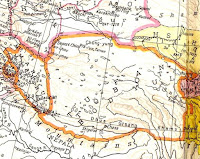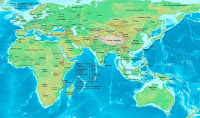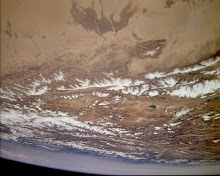Here is another article on Urdu appearing in the Dawn Newspaper! But
the issue is not whether Urdu is
linguistically different from Hindi in terms of origin. The origins of Urdu
could well be from one of the Apabhraṃśa or the kindred vernacular dialects
which
presumably included Hindi which were spoken in the very same
historical area of the Upper Doab and in the Western Rohilkhand and Urdu may
well have an origin parallel with and distinct from Hindi though both the
original languages being kindred languages spoken in the same historical area
of the Upper Doab and in the Western Rohilkhand were very apparently very
similar. To begin with the name Urdu was not even prevalent and the whole comprehensive language was only called Hindavi or Hindi. But that was at a time when the Turko –Persian influence had not yet
set in with the invasion and advent of the Chagatai Mughals who established a
Persianate State in India.
As stated by Michael Prawdin in "Builders of the Mogul
empire", Akbar's promulgation of Din Ilahi should not be
therefore taken as the half-insane act of a vain-glorious autocrat, imagining
himself to be God's representative on earth, but as an effort to introduce some
framework of law and custom which would justify his rule and make him the
righteous sovereign of a foreign country in which he was making his
empire. Because at this time all laws were based on religion, this
framework had to be a religious one, a divine pronunciation of truth, but just
because it had to be religious it was bound to fail. It is reported of Abul
Fazl, who with his father was one of the chief architects of Din llahi, that
while propagating it he at the same time employed a dozen scribes to copy the
Koran for him. Then, the Mughal army were a horde of thugs and criminals and were
pillaging the land of India had to necessarily communicate with the
native Indians and they as alien foreigners were not
conversant with Indian vocabulary and had to supplant Indigenous Indian
vocabulary with Persian, Turkish or Arabic vocabulary while necessarily having
to communicate with the natives in their own language and they resorted to
writing the language with the Perso- Arabic script. This language used by the
alien nobility became known to be Urdu or the language of the nomadic horde
residing in tents or camps! Sher Shah Suri, for example

was an Indigenous Indo-Aryan Indic Pashtun Indian ruler whose ancestors were
from the historic Mandesh area of Ghor (Samskrit Man Desh) in Afghanistan and
he used Devanagari script in his coins. The Suri dynasty traced its origin from
the Ghorids of Ghor, a formerly Hindu and later Islamic dynasty originating
from Mandesh in the Ghor region of the fastness of the Hindukush of modern-day
central Afghanistan. The Mughal invaders never really Indianised themselves and
endeavoured to create a Persianate State in India and one of the reasons for
the decline and fall of the Mughal Empire was because amongst the Muslim
nobility, there were two distinct classes viz the Hindustani faction and the Mughal faction.
The Mughal faction comprised those whose ancestry was either Irani and Turani and they
detested and suspected the Hindustani Muslims and considered themselves
superior racially and considered Indian Muslims to be inferior to them and
there was a continual struggle for control of power and authority. The
Hindustani Muslims comprised of inter alia the Sayyids of Barha, the Afghan
nobles, and Khan-i-Dauran, whose ancestors came from Badakhshan in the far
north of the India and other indigenous Indian Muslims whose ancestors had been
Hindus. The foreign Muslims were arbitrarily called
Mughals, but were really either Turani or Irani. The foreign nobles of diverse
origin, were opposed as a class to the members of the Hindustani party and as
colonizers had a vested interest to ensure that the Indian Muslims did not
identify themselves with their brethren fellow Indians professing the Hindu
faith lest the same would expose and isolate the Mughal faction and they
patronized foreign cultural and religious terminology and vocabulary in order
to further their imperialist ambitions in the bag and baggage of Islam. The
same status quo continues to this date as the descendants of the Mughal faction
continue to be amidst us. The foreign Mughals interrupted the history of India.
Had they not invaded, India’s beloved indigenous Lodi dynasty or Sur
Dynasty would have obviously eventually re-unified the whole of the
Sub-continent of India! In the present scenario, the predominant Muslim
population in the sub-continent of India are descendants of Hindu converts and
belong to the Indo-Aryan ethnicity. Once the predominant Muslim people of the
sub-continent of India rediscover their glorious Indo-Aryan ancestry,
heritage and ethos, which are all extraneous to their profession of the faith
of Islam and their religious beliefs, they would Indianise their language and
script. The phenomenon will be something that will first happen in the
sub-continent of India not in India but in Pakistan and when it happens, it will not
be under duress or coercion but due to a renaissance and their rediscovery of their very own
Indo-Aryan ancestry, heritage and ethos. It is not as though the
Pakistanis are an inferior people and unworthy of it. As stated in the article,
Max Muller, the renowned linguist, has given us a guiding principle in this
regard pertaining to the criterion for a language, Viz. “ the classification of
a language and its relationship with the other language is based on
morphological and syntactical structures of that language and vocabulary has
very little importance in this regard…”! Take the instance of another Indian language, Pashtu: “The sentence construction of Pashto
is akin to that of Hindi. Unlike Persian, but as in the Prakrits, the Pashto
noun comes after the adjective and the possessor precedes the possessed in the
genitive construction. The verb generally agrees with the subject in both
transitive and intransitive sentences. An exception occurs when a completed
action is reported in the past tense. In such cases, Pashto forms are the same
as Hindi forms: the verb agrees with the subject if it is intransitive and with
the object if it is transitive”. Pashto has been considered an Indic i.e. Indo Aryan Indian
language , rather than an Iranian, language: “The Pakkhto, likethe Hindi, is a dialect of the Sanskrit as
regards its grammaticalconstruction, only Persianised in
respect to the bulk of the words composing it”, according to Bellew. (Henry Walter Bellew, A Grammar of the Pukkhto or Pukshto
Language, London, 1867) The reality is that other than the
supplanting of the indigenous Indo-Aryan vocabulary and terminology with
Turko-Persian vocabulary and the substitution of the indigenous Indo-Aryan
Brahmi/Devanagari script with the invasive Perso-Arabic script, Urdu is not a
different distinct language and is the same as Hindi which in theory retains
the native indigenous Indo-Aryan terminology and the indigenous
Indo-Aryan Devanagari script. If Urdu was a distinct separate language, Urdu
ought to have a distinct grammar and distinct original native vocabulary or
words which are not invasive loanwords from Persian, Arabic or
Turkish. There are none whatsoever which can confer Urdu with the
status of a distinct independent language. The so-called Urdu words are per se
not at all Urdu words but only invasive loanwords which supplanted indigenous
vocabulary. Also, Urdu does not gave a distinct grammatical structure and
syntax distinct from Hindi. Hindi is an Indo-Aryan language derived from
Proto-Indo-Aryan Samskrit and hence the language has Indo-Aryan Samskrit words
which are not loanwords, just like French is a Romance Language directly
descended from Latin and her words are predominantly derived from Latin, or
Persian is a Proto-Iranian language and hence her native words are
derived from Iranian. There are foreign phrases used in Urdu but these phrases
are not per se part of the Urdu language which can
confer a distinct language status on Urdu. English for example uses foreign
phrases or maxims like inter alia coup d’
etat or carte blanche of fait accompli or in
absentia or modus operandi or magnum
opus or obiter dictum or persona non grata or ipso
facto or quid pro quo or sui generis or vis-à-vis or volte-face. The
real issue is the Indo-Aryan identity of the people of Pakistan. Language
has nothing whatsoever to do with religion and has to do with nationality and
ethnicity. Samskrit or Hindi is not a Hindu language but is the Indo-Aryan and
Indic Indian language and the people of Pakistan and Afghanistan are
predominantly Indo-Aryan and once they appreciate their national identity and ethnicity,
a revival of nationalism will inevitably result in the discarding of the alien
predominant Turco Persian vocabulary and the restoration of the indigenous Indo
Aryan terminology and script. For example the Persian word used for the Arabic
word for God is Khuda which is a Persian word derived
from xvatay or xwadag meaning lord, ruler of
Master derived from Middle Iranian rather than the Arabic
word, Allah and the word Khuda is ultimately derived from India’s Samskrit language Svabhava or svadhava which
literally means own being or own essence or self powered which later became Kwadava and subsequently Khuda!
On scrutinizing archaeological and textual evidences from the
Trans-Kuen Lun Range state of Khotan in Greater India adjoining India Proper on the
Sanju-la and Hindu-tash Passes section in Ladakh of the Kuen Lun Range on the
International Border of India, the Indic Indo-Aryan Indian origins of the word
Khuda is apparent. The word Khuda is even used predominantly in
the Sub-continent of India particularly Afghanistan and
Pakistan. The word Khuda was used as a noun in reference to Ahura
Mazda. The issue is whether the word Allah is the Arabic word for God, or
whether the name Allah is the name of an Arabian God amongst
many other Gods and Goddesses like Al-Lat, Al-Uzza, or Manat. Although Persian
belongs to the Proto-Iranian branch, It borrowed and assimilated many terms
from the Indo-Aryan Samskrit especially during the cultural exchange and the
influence of Buddhism and Hinduism in ancient Iran. As
Muzaffar Hussain says in “Spell of Hindi on Pakistanis”,
“Can Pakistan Run Away From shadow of
India??”, “…Therefore, truly speaking, the Arabic and
Persian words can be termed as "foreign" to the
subcontinent. While the words of Braj, Bhojpuri, Avadhi or Malvi are
indeed very much indigenous. The Pakistanis along with their Hindi-baiter
Indian cousin should shun the Arabic or Persian words if at all they are so
averse to "foreign" words. But blind dogma can never be countered
with reason. This chauvinism went to such an extent that the Pakistanis began
saying Allah Hafiz when they realised that Khuda in Khuda Hafiz hails from
Iranian culture, which today belongs to the Shias of Iran, a bete noire for
all Sunnis. Thus the Pakistanis' inability to do away with Hindi
words from their "living speech is an indication that Hindi
indeed is a natural speech, a "living speech" of the
subcontinent. What keeps Hindi and Urdu apart is the "left-going"
script of Urdu. If this dividing factor is removed then Pakistan has forty
million Hindi-speaking population. Pakistani schools do not teach Hindi. But it
is part of the "Indian studies". At one time Lahore University had
courses in Hindi up to post graduate level…”.
In the French language, there is the Académie française which
regulates the excessive usage of foreign words in French. In Persian, there is
the The Academy of Persian Language and Literature to protect
the purity of the Persian Language. Ferdowsi, in fact, was a motivation behind
Reza Shah's decision to remove the foreign loanwords from Persian, replacing
them with Persian equivalents. In 1934, Reza Shah ordered to rebuild Ferdowsi's tomb and set up a
country-wide ceremony in honor of a thousand years of Persian literature since the time of
Ferdowsi, titled Ferdowsi Millenary Celebration, inviting
notable Iranian and foreign scholars. The academy strives to protect the
integrity of the Persian language. It heads the academic efforts for linguistic
research on the Persian language and its sister Iranian languages. It has also
created an official orthography of Persian. The attention of the academy has
also been towards the persistent infiltration of Persian, like many other
languages, with foreign words. During the 8th to the 10th Centuries, there
was the period of Persian renaissance or Persian Revival when the Indo-European
Iranians quite rightly realized that under the bag and baggage
of Islam, the Arabs were surreptitiously suppressing the Persian
language and their cultural heritage was being erased. Persian was forced to
absorb invasive alien and foreign Arabian words, Phrases, and grammatical
structures. The Persians to uphold their national identity, reclaimed their
linguistic heritage and caused lexical purification to take place by
replacement of the invasive Arabic loanwords with original native Persian
equivalents and the promotion of the use of pure Persian vocabulary, and the
restoration of Persian grammatical structures and the assertion of Persian
cultural identity. There was a promotion of Persian identity wherein the
distinct Indo-European Aryan Persian identity and culture was
emphasized, separate from invasive alien and foreign Arabic cultural
and linguistic dominance. There was an emphasis on the pre-Islamic Persian
heritage including Zoroastrianism and ancient Persian Pre-Islamic
history. The old script for writing Persian was the Pahlavi Script
prior to the 7th Century which was completely displaced by the
9th century officially by the Tahirid, Samanid, and Saffarid
dynasties. In Turkish, the Turkish Language Association (TDK) was established
in 1932 under the patronage of Mustafa Kemal Atatürk, with the aim of conducting research on Turkish. One of the
tasks of the newly established association was to initiate a language reform to replace alien and
foreign invasive loanwords of Arabic and Persian origin
with Turkish equivalents. By banning the usage of imported words in the press,
the association succeeded in removing several hundred foreign words from the
language. While most of the words introduced to the language by the TDK were
newly derived from Turkic roots, it also opted for reviving Old Turkish words
which had not been used for centuries. However, In India and Pakistan, we are
unworthy of such a renaissance as we are inferior people and we should not
endeavour to purify Hindi or Hindustani and rid the language of excessive
Arabic, Turki and Persian words as that would be construed as communalism by
the descendants of the Ural- Altaic Turko-Mongol Chaghattai Mughals and
Persians like the Geelanis and Owaisis who under the façade or garb of
communalism and antagonism towards Hindus, subvert Indian
Nationalism amongst Indian Muslims under the façade that they are the leaders
and spokespersons of the Muslim community in the Sub-Continent of India!
If Urdu is really a distinct independent language, derived from
the fusion of Persian, Arabic, Turkish and Indian, let Saudi Arabia, Persia, West Turkistan including Uzbekistan, Central Asia, and Turkic Anatolia (Asia Minor) make Urdu their lingua franca and their
language par excellence of science, arts, culture and literature. The cat will be out
of the bag and skeletons would tumble out of the closet! They won't, because the purpose of Urdu was only solely
cultural and linguistic imperialism and subjugation in the sub-continent of
India and Urdu has no other purpose whatsoever, and the people of Pakistan will eventually realise
this.



















